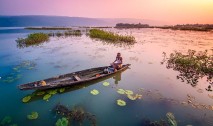Climate
Climate Change
Bangladesh is one of the most climate change vulnerable countries in the world and the impact of climate change may be even worse than that anticipated (MoEF, 2008). Floods, tropical cyclones, storm surges and droughts are likely to become more frequent and severe in the coming years. The 4 th Inter-Governmental Panel on Climate Change (IPCC) Report predicts that seasonal (pre-monsoon) rainfall will increase up to 31% in 2099, resulting in higher river flow during the monsoon season. Global warming will cause sea level to rise between 0.18 and 0.79 meters in 2099. In response to this, the Bangladesh has recently developed the Bangladesh Climate Change Strategy and Action Plan (BCCSAP, 2009) for building a climate resilient development framework through adaptation and mitigation. Adaptation for physical infrastructure is one of the six pillars in the BCCSAP, which stresses the need to deal with the likely impacts of climate change. The projected global average surface warming and sea level rise at the end of the year 2100 based on AOGCMs is presented

Emission Scenarios
- A1 - a future world of very rapid economic growth, global population that peaks in mid-century and declines thereafter, and the rapid introduction of new and more efficient technologies. Three sub groups: fossil intensive (A1FI), non-fossil energy sources (A1T), or a balance across all sources (A1B).
- A2 - A very heterogeneous world. The underlying theme is that of strengthening regional cultural identities, with an emphasis on family values and local traditions, high population growth, and less concern for rapid economic development.
- B1 - a convergent world with the same global population, that peaks in mid-century and declines thereafter, as in the A1 storyline.
- B2 - a world in which the emphasis is on local solutions to economic, social and environmental sustainability
There is no specific or comprehensive study on climate change impact on the haor area. However, projections made by the IPCC (4th Assessment) for south Asia as well as other projections could be considered for the haor region for insight into climate change impact, adaptation and mitigation.
Driving Forces
The driving forces at different levels shape future developments. Many parallels and linkages between forces at different levels contribute in adopting policies for development of the future economy. Following are the major driving forces controlling the future development of the haor region:
- Pressure on agriculture Land
- Pressure on fragile ecosystems
- Urbanization and migration
- Transportation system
- Economic diversification
- Dependency on local resources
- International demand for conservation of wetlands
- Initiation of agricultural technologies
- Ownership of wetland areas
- Recurrence of water related risks and hazards
- Social change
- Local initiatives and decentralization of power
- Availability/arrangement of fund







